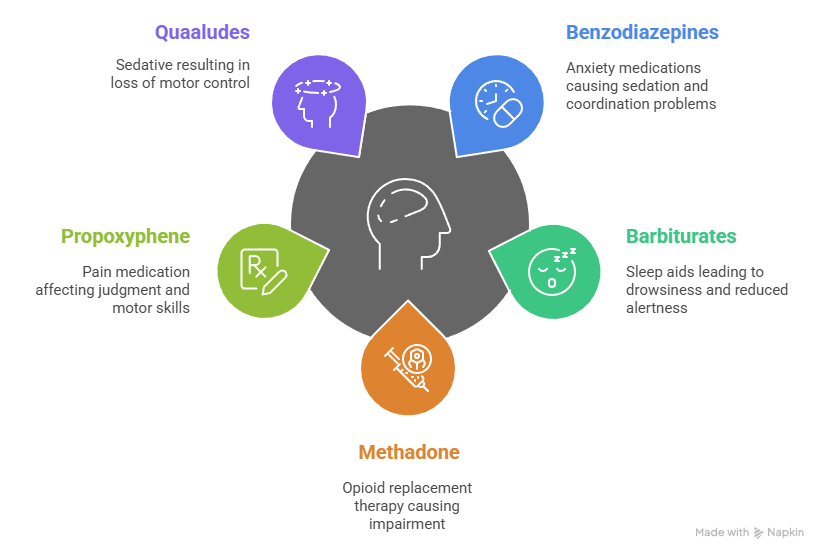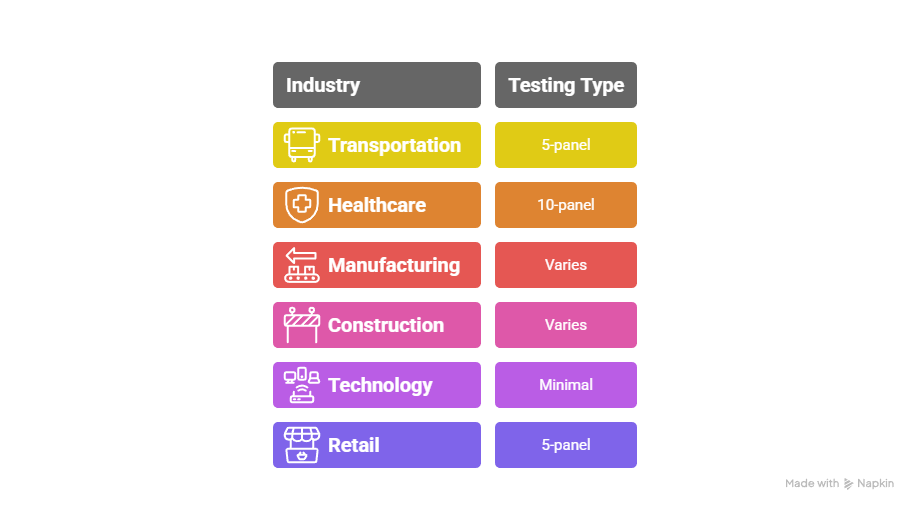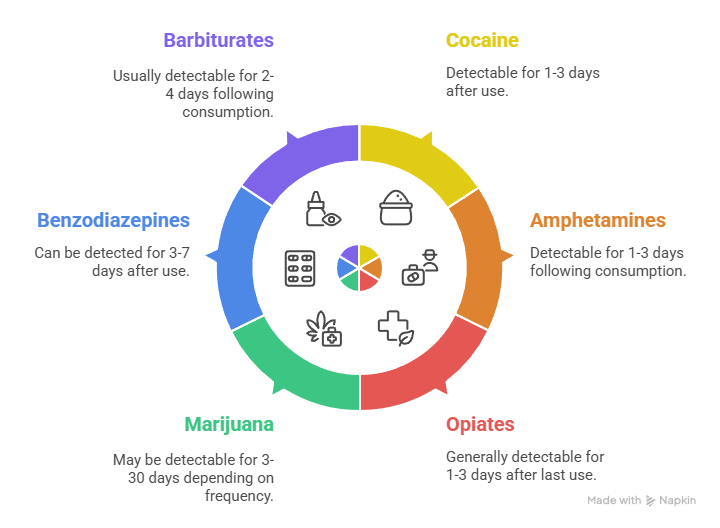The choice between 5-panel and 10-panel drug tests depends on industry requirements, budget constraints, and specific workplace safety needs. 5-panel tests cover basic federally mandated substances while 10-panel tests provide expanded detection for prescription drugs and additional controlled substances.
Key Takeaways
- 5-panel drug tests detect the five most common illegal substances (marijuana, cocaine, amphetamines, opiates, and PCP) and are required for DOT-regulated positions.
- 10-panel drug tests include all 5-panel substances plus additional prescription medications like benzodiazepines, barbiturates, methadone, propoxyphene, and Quaaludes.
- Cost differences range from $30-50 for 5-panel tests versus $50-80 for 10-panel tests, making budget a significant factor for many employers.
- Industry preferences vary significantly, with transportation and safety-sensitive roles favoring comprehensive 10-panel screening.
- Detection windows remain consistent across both panel types, typically ranging from 1-3 days for most substances to 30 days for marijuana.
- Legal compliance requirements differ by state and industry, with some sectors mandating specific panel configurations for employment eligibility.
Understanding Drug Testing Panel Basics
Drug testing panels represent standardized groupings of substances that employers screen for during pre-employment testing. The number in the panel name indicates how many different drug categories the test examines. Most workplace drug screening programs utilize either 5-panel or 10-panel configurations today.
The selection between these two primary options affects both the comprehensiveness of screening and associated costs. Employers must balance regulatory requirements, workplace safety concerns, and budget limitations. The decision impacts hiring processes, legal compliance, and overall workplace safety outcomes.
Federal regulations mandate specific testing requirements for certain industries and positions. DOT-regulated jobs require 5-panel testing as the minimum standard. Some employers choose to exceed these requirements with more comprehensive screening approaches.
Complete 5-Panel Drug Test Breakdown
The 5-panel drug test serves as the foundation for most employment screening programs across the United States. This configuration tests for five specific drug categories that represent the most commonly abused illegal substances. Federal regulations mandate 5-panel testing for Department of Transportation positions and many government contractor roles.
| Drug Category | Detection Window | Common Effects |
| Marijuana (THC) | 3-30 days | Impaired coordination, delayed reactions |
| Cocaine | 1-3 days | Erratic behavior, poor judgment |
| Amphetamines | 1-3 days | Hyperactivity, unpredictable actions |
| Opiates | 1-3 days | Drowsiness, impaired motor skills |
| PCP | 7-14 days | Hallucinations, violent behavior |
These substances represent the core illegal drugs that pose significant safety risks in workplace settings. The 5-panel configuration provides essential screening coverage while maintaining cost-effectiveness for employers with limited budgets.
Why 5-Panel Tests Remain Popular
The 5-panel drug test maintains widespread adoption due to its federal mandate for transportation workers. Many employers appreciate the balance between comprehensive screening and reasonable costs. This testing approach addresses the most common substance abuse issues in American workplaces effectively.
Cost-conscious organizations often start with 5-panel testing to establish their drug screening programs. The lower price point allows smaller companies to implement workplace safety measures without significant financial burden. This accessibility helps promote safer work environments across various industries and company sizes.
Limitations of Basic 5-Panel Screening
The 5-panel approach does not detect prescription drug abuse, which has become increasingly common in workplace settings. Many employees with legitimate prescriptions may still pose safety risks if they misuse medications. The basic panel also misses synthetic drugs and newer substances that weren't prevalent when testing standards were established.
Comprehensive 10-Panel Drug Test Analysis
The 10-panel drug test expands screening capabilities by including all five substances from the standard panel. It adds five additional drug categories to address prescription drug abuse concerns. This enhanced testing approach provides more thorough detection of controlled substances that may impair workplace performance.

- Benzodiazepines: Anxiety medications that cause sedation and coordination problems
- Barbiturates: Sleep aids that create drowsiness and reduced alertness
- Methadone: Opioid replacement therapy drug that can cause impairment
- Propoxyphene: Pain medication that affects judgment and motor skills
- Quaaludes: Sedative that results in loss of motor control
Healthcare facilities, manufacturing plants, and safety-sensitive industries often prefer this comprehensive approach. The expanded detection capabilities help identify a broader range of potentially impairing substances.
Advanced Detection Capabilities
The additional substances in 10-panel testing focus on prescription medications that are frequently misused. These drugs can be just as impairing as illegal substances in workplace environments. Many employees have legitimate access to these medications through healthcare providers.
The expanded panel helps employers identify potential safety risks from both illegal drug use and prescription medication misuse. This comprehensive approach supports more thorough workplace safety programs. It also demonstrates employer commitment to maintaining drug-free work environments.
When 10-Panel Testing Makes Sense
Organizations with safety-sensitive positions benefit most from expanded drug testing panels. Healthcare facilities need comprehensive screening due to employee access to controlled substances. Manufacturing companies with heavy machinery operations require thorough substance abuse detection.
Companies with previous workplace accidents related to substance abuse often upgrade to 10-panel testing. The additional cost becomes justified when weighed against potential liability and safety concerns. Legal departments frequently recommend expanded testing for risk management purposes.
Industry-Specific Drug Testing Preferences
Different industries demonstrate distinct patterns in drug testing panel selection based on regulatory requirements. Transportation companies universally utilize 5-panel testing due to DOT mandates. Healthcare organizations frequently implement 10-panel screening to address prescription drug access concerns.
Manufacturing sectors typically choose between panels based on safety considerations and budget constraints. Construction companies often select testing approaches based on project requirements and client specifications. Government contractors must comply with federal testing standards regardless of industry preferences.

- Transportation: DOT-mandated 5-panel testing for all safety-sensitive positions
- Healthcare: 10-panel preferred due to controlled substance access concerns
- Manufacturing: Varies by safety risk level and machinery operation requirements
- Construction: Client contracts often specify minimum testing requirements
- Technology: Generally minimal testing unless safety-sensitive roles involved
- Retail: Basic 5-panel testing most common for loss prevention purposes
The regulatory landscape continues evolving as workplace substance abuse patterns change. Industry associations often provide guidance on appropriate testing approaches for specific sectors.
Transportation and DOT Compliance
All DOT-regulated positions in trucking, aviation, maritime, pipeline, railroad, and mass transit sectors must use 5-panel testing. These industries cannot deviate from federal requirements for covered employees. However, companies can supplement mandatory testing with additional screening for non-DOT positions.
Healthcare and Safety-Critical Operations
Healthcare facilities commonly select 10-panel drug tests due to controlled substance access and patient safety concerns. Pharmaceutical companies implement comprehensive screening to protect product integrity and regulatory compliance. These industries justify higher testing costs through reduced liability exposure and enhanced safety measures.
Cost Analysis and Budget Considerations
Financial factors significantly influence drug testing panel selection decisions for most employers. The cost difference between 5-panel and 10-panel tests must be evaluated against potential workplace safety benefits. Budget-conscious employers often start with basic testing and upgrade as programs mature.
| Test Type | Cost Per Test | Annual Cost (50 Tests) | Additional Coverage |
| 5-Panel | $30-50 | $1,500-2,500 | Basic illegal drugs only |
| 10-Panel | $50-80 | $2,500-4,000 | Includes prescription drugs |
| Difference | $20-30 | $1,000-1,500 | 5 additional drug categories |
Small businesses must carefully consider testing costs against potential liability reduction and safety improvements. The additional investment in 10-panel testing may prevent costly workplace accidents or workers' compensation claims.
Legal Compliance and State Variations
Understanding legal obligations surrounding workplace drug testing ensures proper panel selection and implementation procedures. Federal regulations establish minimum standards for certain industries and positions. State laws may impose additional requirements or restrictions on testing practices that affect panel choices.
California employers must navigate specific notification requirements and privacy protections that affect testing procedures. Some states restrict testing to safety-sensitive positions or require reasonable suspicion before conducting screening. Union agreements often specify acceptable testing parameters and panel configurations.

- Federal Requirements: DOT positions must use 5-panel testing regardless of state laws
- State Restrictions: Some states limit when and how employers can conduct drug testing
- Industry Standards: Professional licensing boards may establish specific testing requirements
- Union Contracts: Collective bargaining agreements often specify testing parameters
- Privacy Laws: State privacy protections may affect testing procedures and result handling
Employers should consult with employment law attorneys to ensure compliance with all applicable regulations. Legal counsel can help determine appropriate testing approaches for specific jurisdictions and industries.
Federal vs State Requirements
Federal mandates take precedence over state laws for DOT-regulated positions and federal contractors. However, non-regulated employers must comply with state-specific requirements that vary significantly. Some states require employers to follow specific procedures for drug testing programs.
Detection Windows and Testing Accuracy
Both 5-panel and 10-panel drug tests utilize identical detection methodologies and maintain consistent accuracy standards. Detection windows vary by substance type, usage frequency, and individual metabolism rather than panel configuration. Understanding these limitations helps employers set realistic expectations for their screening programs.
Most substances clear from detectable levels within 1-3 days under normal circumstances. Marijuana may remain detectable for weeks in frequent users due to fat storage properties. PCP can be detected for 7-14 days depending on usage patterns and individual factors.
Testing accuracy exceeds 99% when proper collection and laboratory procedures are followed consistently. Medical review officers help interpret results and identify legitimate medication use that may cause positive results. False positives are rare but can occur due to cross-reactivity with certain medications or foods.

- Cocaine: Typically detectable for 1-3 days after use
- Amphetamines: Usually detectable for 1-3 days following consumption
- Opiates: Generally detectable for 1-3 days after last use
- Marijuana: May be detectable for 3-30 days depending on frequency
- Benzodiazepines: Can be detected for 3-7 days after use
- Barbiturates: Usually detectable for 2-4 days following consumption
Individual variations in metabolism, body composition, and substance usage patterns influence detection outcomes significantly. Employers should understand these variables when interpreting test results and making employment decisions.
Implementation Best Practices
Successful drug testing programs require careful planning, clear policies, and consistent implementation procedures. Employers should establish written policies that specify testing circumstances, consequences, and appeal processes. Training supervisors and HR personnel ensures consistent program administration across the organization.
Chain of custody procedures protect the integrity of test samples and results. Proper documentation prevents legal challenges and supports employment decisions based on testing outcomes. Regular program evaluation ensures continued effectiveness and legal compliance as regulations evolve.
Communication with employees about drug testing policies promotes understanding and compliance. Clear expectations help prevent substance abuse issues before they impact workplace safety. Providing resources for employees struggling with substance abuse demonstrates employer commitment to worker wellbeing.
Policy Development and Communication
Written drug testing policies should clearly outline testing circumstances, procedures, and consequences for positive results. Employees need advance notice of testing requirements and appeal processes for disputed results. Regular policy updates ensure compliance with changing regulations and industry standards.
Choosing Testing Providers
Selecting qualified testing providers ensures accurate results and legal compliance for drug screening programs. Certified laboratories must follow strict quality control procedures and chain of custody requirements. Medical review officers provide expert interpretation of results and identify legitimate medication use.
Compare provider services, costs, and turnaround times when selecting testing partners. Look for certifications from organizations like SAMHSA or CAP to ensure quality standards. Establish clear service level agreements for result reporting and customer support needs.
Making the Right Choice for Your Organization
Selecting between 5-panel and 10-panel drug testing requires careful evaluation of multiple factors affecting your workplace. Industry requirements, budget constraints, safety concerns, and regulatory compliance needs all influence this decision. Organizations should assess their specific risk factors and develop testing strategies that align with business objectives.
Consider implementing 5-panel testing if your organization operates in DOT-regulated industries or maintains limited testing budgets. This approach provides essential screening coverage for the most common illegal substances at reasonable costs. Many employers find 5-panel testing sufficient for general workplace safety needs.
Choose 10-panel testing for safety-sensitive environments, healthcare facilities, or positions involving controlled substance access. The comprehensive screening justifies additional costs through enhanced workplace safety and reduced liability exposure. Organizations with previous substance-related incidents often benefit from expanded testing capabilities.
The decision should reflect your organization's commitment to workplace safety while remaining practical and legally compliant. Regular program evaluation ensures your chosen approach continues meeting evolving business needs. Consider consulting with legal counsel and occupational health professionals for optimal program design.
Factors to Consider
Budget constraints often determine initial testing panel selection for smaller organizations. However, the cost of workplace accidents may exceed testing expenses significantly. Safety-sensitive positions typically justify more comprehensive screening approaches regardless of additional costs.
Regulatory requirements may mandate specific testing approaches for certain industries or positions. Employee union agreements can also influence testing panel selection and implementation procedures. Consider all stakeholder perspectives when developing your testing strategy.
Future Considerations
Workplace substance abuse patterns continue evolving with new synthetic drugs and changing prescription medication usage. Testing panels may need updates to address emerging substances and abuse trends. Stay informed about industry developments and regulatory changes that could affect your program.
Consider scalability when selecting initial testing approaches to accommodate future growth or requirement changes. Flexible testing partnerships allow program modifications without significant disruption to operations. Regular program reviews help identify improvement opportunities and compliance updates.
Conclusion
The choice between 5-panel and 10-panel drug tests ultimately depends on balancing comprehensive screening needs with practical considerations. While 5-panel tests provide essential coverage for federally mandated substances at lower costs, 10-panel tests offer expanded detection capabilities crucial for certain industries. Employers should evaluate their specific workplace risks, legal obligations, and financial constraints when selecting their preferred approach. Consulting with employment law attorneys and occupational health professionals ensures optimal program design that protects both workplace safety and legal compliance interests.
Frequently Asked Questions
What drugs are tested in a 5-panel vs 10-panel drug test?
A 5-panel drug test screens for marijuana, cocaine, amphetamines, opiates, and PCP, while a 10-panel test includes these five plus benzodiazepines, barbiturates, methadone, propoxyphene, and Quaaludes. The 10-panel test provides expanded coverage for prescription drug abuse.
How much more expensive is a 10-panel drug test compared to a 5-panel?
10-panel drug tests typically cost $20-30 more per test than 5-panel screening, with 5-panel tests ranging from $30-50 and 10-panel tests costing $50-80. For organizations testing 100 employees annually, this represents an additional investment of $2,000-3,000.
Do DOT regulations require 5-panel or 10-panel drug testing?
DOT regulations specifically mandate 5-panel drug testing for safety-sensitive transportation positions. Employers in trucking, aviation, maritime, pipeline, railroad, and mass transit must use 5-panel tests, though they may add supplemental testing for non-DOT positions.
Which industries typically use 10-panel drug tests?
Healthcare facilities, pharmaceutical companies, manufacturing plants with safety-sensitive operations, and organizations with prescription drug access commonly implement 10-panel testing. These industries justify higher costs through enhanced workplace safety and reduced liability exposure.
How long do substances stay detectable in both 5-panel and 10-panel tests?
Detection windows remain identical regardless of panel type, typically ranging from 1-3 days for most substances including cocaine, amphetamines, and opiates. Marijuana may be detectable for 3-30 days depending on usage frequency, while PCP can be detected for 7-14 days.
Can employers choose different drug testing panels for different positions?
Yes, employers can implement varying drug testing requirements based on position sensitivity, regulatory requirements, and safety concerns. Many organizations use 5-panel testing for general positions and 10-panel screening for safety-critical roles, provided they comply with applicable state and federal laws.
Additional Resources
- Department of Transportation Drug Testing Requirements
https://www.transportation.gov/odapc/drug-testing - National Institute on Drug Abuse Workplace Resources
https://nida.nih.gov/research-topics/workplace-resources - Equal Employment Opportunity Commission Drug Testing Guidance
https://www.eeoc.gov/laws/guidance/ada-questions-medical-examinations
